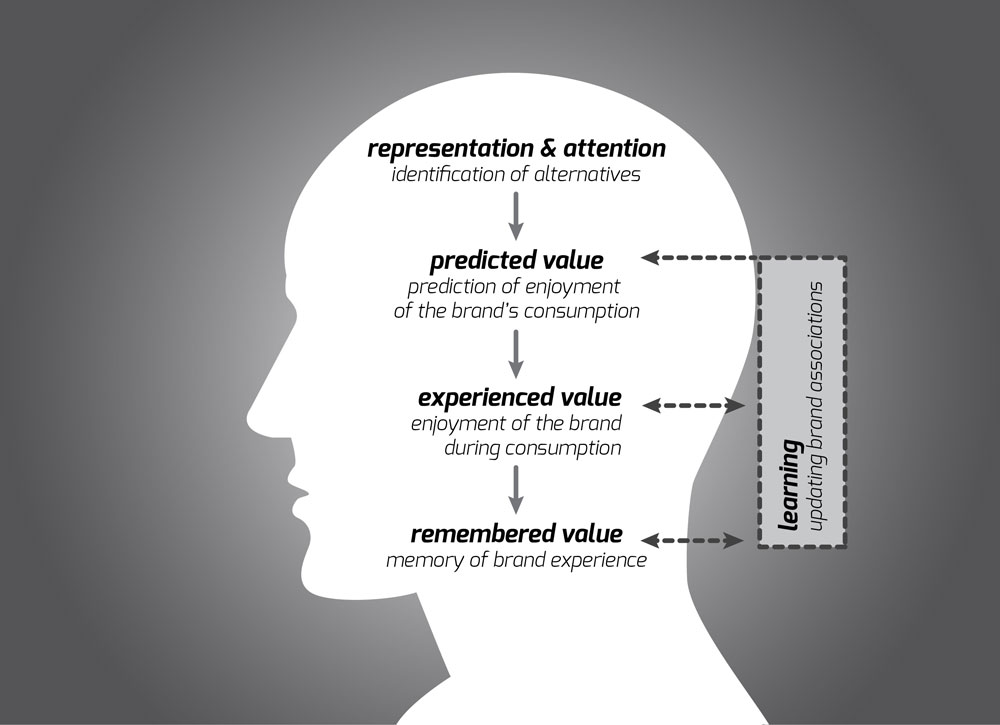
In the previous article, we explored the incentive of consumers’ purchases, the underlying process of decision-making, and the phases and steps this process consists of. In this article, we will try to reveal how the unconscious cognitive process of consumers’ brains results in brand preference.
Bra(i)nding
There has been significant application of neuroscience in marketing, to the consumer decision-making process in particular, over the past decade, drawing the interests of both the corporate world and branding experts. Prior work in consumer psychology (Kahneman & Snell, 1992; Kahneman, Wakker, & Sarin, 1997; Rangel, Camerer, & Montague, 2008; Wirtz, Kruger, Scollon, & Diener, 2003) has provided a simple framework which directly relates to branding questions and points the way to future applications in consumer research. It resembles the framework process that has been explored previously, but casts further light into how the brain interprets the external stimulus. The framework divides the stages that are required for brand preference formation over time into four basic components: (1) representation and attention, (2) predicted value, (3) experienced value, and (4) remembered value and learning.
Representation
The first process in brand decisions involves forming the representation of the choice alternatives—that is, brand identification. This entails processing the incoming information, so that different options for choice are identified (e.g., different beer brands). At the same time, the consumer needs to integrate information on internal states (e.g., thirst level) and external states (e.g., location, social context) that drive attention. This component reflects the “search for information” of our previously examined model of decision making. For example, when faced with a choice between drinking a Heineken or Beck’s (incoming information), a consumer’s choice is likely to depend on his/her own level of thirst (an internal state) and what her friend chooses to drink (an external state).
Humans are predominately visual creatures, and most of the incoming information we receive is visual. The human visual system allows for rapid brand and product identification. Recent magnetoencephalography (MEG) studies have showed that consumers can identify two different food brands and make up their mind about which one they prefer in as little as 313 ms. Additionally, processes involved in the representation phase do not even have to be conscious, as recent research has demonstrated that unconscious processes equally shapes how we represent our decision-making situations (Chartrand, Huber, Shiv, & Tanner, 2008). One of the key questions at this stage, discussed next, is what consumers pay attention to (i.e., focus on) once they are exposed to an enormous amount of information and have identified choice alternatives (i.e., brands).
Attention
Attention is the mechanism responsible for selecting the information that gains preference above other available information. It has been proven that attention depends on four factors: Salient filters, top-down control, visual selection and working memory. (Knudsen, 2007) Salient filters are activated automatically in order to select the most important information from all the available information. This process is based on the physical features of the visual input: Colors, luminosity, orientation, size, shape, etc. Such factors play a vital role and have a strong impact on the initial eye movements when consumers are exposed to branding information. Taking into consideration that the first four eye movements are made within the first 2.5 seconds of exposure, each product on the shelf has almost 3 seconds to grab the attention of the potential buyer. The salient stimuli will attract the initial eye movements of consumers, and thus may have a profound effect on related consumer behavior.
Namely, at fast decision speeds, a significant number of food choices were biased toward the food items with brighter packaging, even when subjects preferred the taste of alternative food options. Furthermore, there are other automatic biases known to influence what people pay attention to (Glaholt, Wu, & Reingold, 2010). For example, people tend to look toward the upper visual field (Durgin, Doyle, & Egan, 2008) and the right visual field (Efron & Yund, 1996), which may be of importance in the consumer behavior context (e.g., at the point of purchase).
Top-down control depends on internal and external states, goals, and expectations. Information relevant to goal-attainment will be attended to more than irrelevant information. For example, feeling thirsty makes consumers pay attention to drinks more than to other items; hence, looking for a can of Coke will enhance processing of red areas in visual input by increasing the neuronal sensitivity for that particular color.
Predicted Value
Expectation can also modulate what consumers pay attention to. The predicted value of each brand that is available for choice (e.g., Coke vs. Sprite) represents the consumer’s belief about the experienced value of that brand at some time in the future. In other words, the predicted value involves the consumer’s evaluation of how much enjoyment he will derive from consuming a Coke or Sprite. Several studies have investigated how different types of brand associations influence predicted value signals in the consumer’s brain during the decision-making process. Despite the fact that both these two branded products belong to the soft drink industry and are manufactured by the same company, they have been built on two different values. Sprite has been positioned on a fundamental human need, thirst, while Coke has been based on a more sentimental area, happiness. Thus, the predicted value is being derived from the correlation between the consuming brain’s top-down control and brand associations based on either marketing communication or past experience.
Experienced Value
The importance of brand experience from the consumer perspective is that it directly affects not only the satisfaction, but also the brand meaning. The resulting satisfaction with a brand is shaped, in a large way, by the consumer’s expectations as mentioned above. Thus, experienced value is based on the pleasure or solution derived from buying a brand; experienced value consists of the capacity and intensity of the interaction with the brand or product.
Remembered Value and Learning
Consider again our example of choosing between Coke and Sprite. An important signifier of your choice is your memory of previous experiences with the two brands. If you remember that Sprite had a sweeter taste than Coke and Coke more fizzy than Sprite, these experiences may influence your decision. You may remember a recent entertaining Coke commercial, but you have no such memory of a Sprite commercial. Brands work their magic by associating themselves with experiences and emotions which, in turn, affect subsequent retrieval and recognition. Remembered value refers to how different brand associations are encoded, consolidated, and retrieved in the consumer’s memory partly subconsciously. The insights of any experience with a product or brand, or contact with marketing communication, are continuously updating the brand or product associations in the consumer’s mind. The brain is archiving all past experiences, so that it may retrieve them when the decision-making process is about to be initialized again, or during the experiences with the brands.
In sum, neuroscience is providing invaluable insights into human brain processes occurring before or during the decision process. The importance of brand experience from the consumer perspective is that it directly affects not only the satisfaction (experienced value), but also the brand meaning (remembered value). The resulting satisfaction with a brand is shaped, in a large way, by the consumer’s expectations (predicted value). The factors of representation and attention underline the importance of packaging and product design when branding a product, especially in terms of physical features that impact the consumer’s senses and brand identification. Branding experts are laying siege to the underlying decision-making processes of consumers’ associations of brands and products with certain emotions while keeping the product/brand relevant to their needs. Moreover, theoretical and methodological insights from neuroscience can prove especially useful in allowing consumer researchers to better understand the decision-making process and its effects on branding-related behavior. Empirical studies in consumer neuroscience and neuromarketing employ neuroimaging tools, such as biomarkers, to assess responses to marketing stimuli such as brands, advertisements, packaging and to … predict consumer choices! A consumer, branding-related, decision-making pattern that predicts your choices, now wouldn’t that be something?
Photo: Jason Costantza / Flickr
